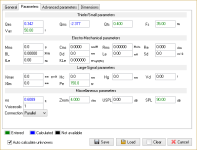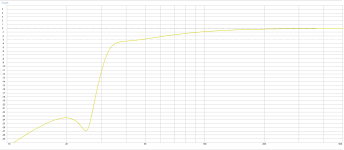This is my first experience with a passive radiator system. I'm constructing them from the bits I have listed below:
1) Enclosures from Braun LS150, internal volume = 53.0 liters
2) 8" KEF KAR 200B subwoofers, T/S parameters:

3) 8" Dayton DSA215-PR passive radiators, T/S parameters:

Putting all parameters into WinISD produced this graph.

Personally, I don't think all of the components would work well together the first time because this build was created at random. As a result, the yielded graph should probably have some modifications.
Firstly, what does this graph tell us? Is it a good or bad result?
Secondly, what should the ideal SPL graph for PR systems look like?
Finally, AFAIK, the passive radiator tuning is similar to that in the vented system, but cone mass altering instead of port length varying. Thus, what should be done for tuning this system to the best/optimum result according to the graph?
1) Enclosures from Braun LS150, internal volume = 53.0 liters
2) 8" KEF KAR 200B subwoofers, T/S parameters:

3) 8" Dayton DSA215-PR passive radiators, T/S parameters:
Putting all parameters into WinISD produced this graph.

Personally, I don't think all of the components would work well together the first time because this build was created at random. As a result, the yielded graph should probably have some modifications.
Firstly, what does this graph tell us? Is it a good or bad result?
Secondly, what should the ideal SPL graph for PR systems look like?
Finally, AFAIK, the passive radiator tuning is similar to that in the vented system, but cone mass altering instead of port length varying. Thus, what should be done for tuning this system to the best/optimum result according to the graph?
It's a slightly downward sloping tuning. May be good to compensate for room gain. I would not add additional weight, as that would lead to an even lower tuning and an "ugly" peak at the lower end.what does this graph tell us?
If you want a more even response try to reduce the volume (or add a second passive radiator).
Can just compare or see required volume for
Normal QB3 vented alignment. And see if the downward slope is same.
The actual cutoff with Passive will be slightly sharper.
But same volume and tuning can be used as a QB3.
I prefer downward slopes with lower tunings.
Not obsessed with high tunings like most to make the graph look
" Flat "
Since in real life. A slight bump of the bass knob on otherwise standard
2 band EQ will give you way more bass the annoying high tuned reflex.
More important to use a volume that is suitable for speakers compliance.
And then just keep tuning slightly below Fs.
No need to tune high and make the transfer function look " Flat"
Since it just makes the tuning higher and again in real life that downward
slope goes away when you turn up the bass knob.
Usually you want 2x passive radiators or double the woofer area
to reduce distortion from the passive. So then its possible to raise tuning.
I have noticed with the Dayton Passive radiators. That they are actually rather
well designed. Especially with just One radiator. Fs is low and they typically need
no weight added when I have modeled them with many 8" drivers.
Normal QB3 vented alignment. And see if the downward slope is same.
The actual cutoff with Passive will be slightly sharper.
But same volume and tuning can be used as a QB3.
I prefer downward slopes with lower tunings.
Not obsessed with high tunings like most to make the graph look
" Flat "
Since in real life. A slight bump of the bass knob on otherwise standard
2 band EQ will give you way more bass the annoying high tuned reflex.
More important to use a volume that is suitable for speakers compliance.
And then just keep tuning slightly below Fs.
No need to tune high and make the transfer function look " Flat"
Since it just makes the tuning higher and again in real life that downward
slope goes away when you turn up the bass knob.
Usually you want 2x passive radiators or double the woofer area
to reduce distortion from the passive. So then its possible to raise tuning.
I have noticed with the Dayton Passive radiators. That they are actually rather
well designed. Especially with just One radiator. Fs is low and they typically need
no weight added when I have modeled them with many 8" drivers.